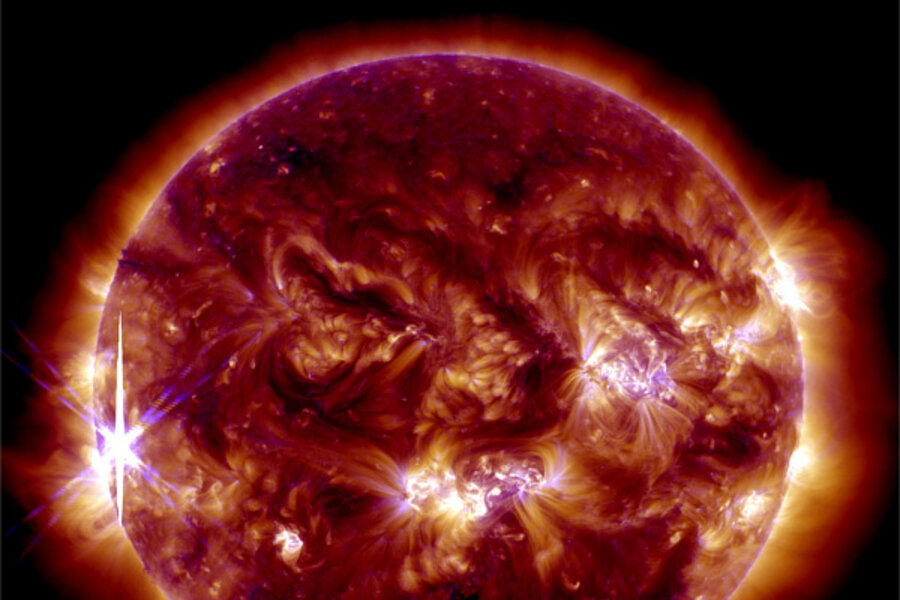Solar flares: X-class (Yes, that's a real thing.)
Loading...
Don't be distracted by Star Trek's M-class planets or X-Men's First Class of students – while the terms have been appropriated by science fiction, M-class and X-class solar flares are very real.
Two enormous solar flares – an X1.7 and X2.1 class, respectively – erupted from the surface of the sun on Friday morning. The smaller flare peaked at 4:01 a.m. EDT, while the X2.1 solar flare peaked seven hours later, at 11:03 a.m. EDT.
The last time the sun released an X-class flare was on May 14, 2013, but there were two weaker M-class flares on Thursday.
The steady stream of solar flares, coronal mass ejections (CMEs), and other solar storms are associated with the solar maximum. Solar storms occur on a roughly 11-year cycle, but the "maximum" isn't a one-day peak, but a prolonged period of more than a year.
The minimum-maximum pattern is more of a gentle sine wave, like a system of rolling hills and valleys, than like the jagged peaks of a heart monitor, says Art Poland, an astrophysicist with George Mason University.
"We're just on the other side of the top of the sine wave right now," says Dr. Poland. "You get your biggest flares and biggest magnetic disruptions on the way down."
It's hard to pinpoint the precise timing of a solar maximum, especially in advance. In recent years, NASA was estimating the maximum would come in 2011, or 2012, or maybe 2013. "You only know afterwards," says Poland, who is the project scientist on SOHO, an observatory orbiting the sun. "You're pinning real data to a sine wave, and it's not a perfect sine wave, so it's hard to tell."
The first X-class flare of the current solar cycle occurred in February 2011. The largest X-class flare so far in this cycle was an X6.9 on Aug. 9, 2011.
What's an "X-class" solar flare?
Solar flares are classified by strength. When the system was created in the mid-1960s, the smallest solar flares were classified as C-class, moderate flares were M-class, and the largest were X-class. Since then, more refined instruments have been able to measure even smaller flares, called A-class and B-class.
A-class flares are almost indistinguishable from background solar radiation, followed by B, C, M and X. Each letter represents a 10-fold increase in the solar flare's energy output, so an X is ten times an M and 100 times a C. An X2 is twice as strong as an X1. An X3 is three times as powerful as an X1, and so on.
The most powerful solar flare ever measured occurred November 4, 2003, during the last solar maximum. It was so powerful that it blinded the sensors watching it, which max out at X17. Later calculations estimated that the flare reached a "whopping" X45.
A-, B-, and C-class flares are too weak to affect Earth in any meaningful way. M-class flares can cause brief radio blackouts at the poles, and are associated with radiation storms that might endanger astronauts. (Those of us on the surface of the Earth are protected from the radiation by Earth's magnetic field, which shields us from most incoming radiation.)
And then there are the X-class flares, which can be – by far – the largest explosions in the solar system. When the sun's magnetic fields cross over each other, loops dozens of times the size of Earth leap up off the sun's surface. The biggest flares can produce as much energy as a billion hydrogen bombs.
Fortunately for us, the sun emits energy in all directions, not just toward Earth, so most of the solar storm activity is blown out harmlessly into space.
When the energy is directed at Earth, flares and coronal mass ejections (CMEs) can harm satellites, communications systems, and even ground-based technologies and power grids.
NASA and NOAA aren't yet sure whether or not Friday's solar flares kicked off a CME, but they haven't seen any evidence of one yet. Even without a CME, X-class solar flares can disturb GPS signals and cell phone reception for as long as the flare lasts, which can be anywhere from minutes to hours.
Both of Friday's solar flares did cause radio blackouts, reported the Space Weather Prediction Center at a 2 p.m. update on Friday afternoon.
"Our Earth is living in a star. We're living in the atmosphere of the sun," says Poland. "We're trying to study (solar flares and CMEs) like weather, and make predictions and monitor them just like we do weather on Earth, so that power companies and satellite operators and others will be prepared well in advance for anything that might happen."






